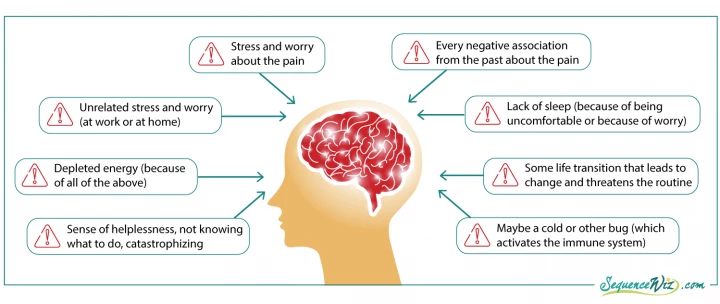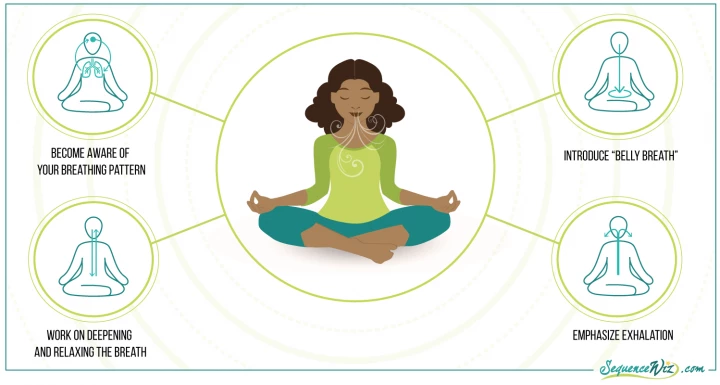Chronic Pain: 4 Steps to Breathing into Discomfort

Some days, when I begin my yoga practice, I can feel the entire physical history of my body: here is that neck tension from staring at the computer all day yesterday, and here is that old hamstring injury from an unfortunate split, and here is that wonky sacrum. Everybody carries a history of past injuries and hurts, but most of the time, your brain chooses not to get alarmed about it, and those experiences of past pain do not rise to the level of a full-blown pain episode.
Other times, your brain decides to be alarmed about a particular sensation based on experience of similar sensations and current context. Other unrelated factors can exacerbate the situation and lead to a full-blown emergency pain-and-stress response.

How Your Body Responds to Emergency Stress
The emergency stress response initiates a cascade of physiological changes in the body. It consists of:
- Endocrine response (release of adrenaline to initiate and amplify sympathetic activation)
- Sympathetic system activation (a branch of an autonomic nervous system responsible for fight-or-flight or freeze response in emergency situations)
- Immune response (increased inflammation to heal wounds and fight toxic invaders)
Using Breathing Techniques to Control Stress and Reduce Pain
Having recurring emergency responses for every suspicious sensation in the body is very taxing on the entire system (and generally unpleasant). What can we do about it? We certainly cannot control how much adrenaline gets dumped into our bloodstream. Still, we can control one aspect of our physiology that gives us access to sympathetic/parasympathetic balance: the breath.
Breath both reflects the inner state of your body and affects it. When your sympathetic system gets activated, you might experience a classic fight-or-flight response, with the body mobilizing all resources to fight or flee. As a result, your breathing becomes fast and happens mostly in your chest. You can even hyperventilate. Or you might experience sympathetic activation as a “freeze” response when the body withdraws to protect itself from the painful experience. This can show up as holding the breath, breathing in a shallow or incomplete way, and overall difficulty with breathing.
It becomes a vicious cycle where the emergency-response breathing pattern persists even after the emergency has passed and continues to signal to the brain that the danger is still present. To get out of this cycle, we need to change the breathing pattern to promote parasympathetic activation (rest-and-digest mode) to reassure the brain that all is well and healing is underway.
The 4 Steps to Use Breath to Manage Chronic Pain
The starting points of working with breath for chronic pain management are:

Step 1: Become aware of your breathing pattern. You cannot consciously change something that you are not aware of. So the first step is to notice your habitual breathing patterns, especially during a pain episode. Do you tend to breathe fast, do you tend to hold your breath, or does your breath become shallow? At any point of the day, bring your attention to your breath and observe it for a few cycles. Simply bringing your attention to your breath might help calm your system down.
Step 2: Work on deepening and relaxing the breath. Deepening the breath has all sorts of physiological benefits for the entire system. Regarding sympathetic/parasympathetic balance, “when your breathing is relaxed, your nervous system receives the message that you are safe and well. This message ignites a cascade of changes in your body and mind that can prevent or interrupt a full emergency pain-and-stress response. The result is that you immediately feel better while teaching the mind and body a healthier way to respond to pain and stress.”(1)
Step 3: Introduce “belly breath.” When the sympathetic system is activated, you are more likely to take shallow breaths, primarily in the chest. Intentionally expanding your belly out on the inhalation as if breathing into your belly has a grounding and calming effect on the entire system.
Step 4. Emphasize exhalation. Every time you inhale, you activate your sympathetic system a bit, and every time you exhale, you activate your parasympathetic system. That is why emphasizing long, flowing exhalations helps facilitate the rest-and-digest response and turns off the alarms in your brain.
For any breathing techniques to have an effect, it is recommended to do it for at least 12 breath cycles. Not all practices will work for all people. Breathing should never be forced.
In the short run, simple breathing practices can effectively calm down the nervous system and help lessen the pain. In the long run, healthy breathing patterns help make the brain less reactive to minor instances of pain. Breathwork becomes more impactful with consistent practice over time.
Study core strength and more with Olga Kabel and YogaUOnline – Yoga for Posture Improvement with Focus on Core Strengthening and Axial Extension.
Reprinted with permission from Sequence Wiz.
 Educated as a school teacher, Olga Kabel has been teaching yoga for over 14 years. She completed multiple Yoga Teacher Training Programs but discovered the strongest connection to the Krishnamacharya/ T.K.V. Desikachar lineage. She studied with Gary Kraftsow and American Viniyoga Institute (2004-2006) and received her Viniyoga Teacher diploma in July 2006, becoming an AVI-certified Yoga Therapist in April 2011. Olga is the founder and managing director of Sequence Wiz- a web-based yoga sequence builder that assists yoga teachers and yoga therapists in creating and organizing yoga practices. It also features simple, informational articles on how to sequence yoga practices for maximum effectiveness. Olga strongly believes in the healing power of this ancient discipline on every level: physical, psychological, and spiritual. She strives to make yoga practices accessible to students of any age, physical ability, and medical history, specializing in helping her students relieve muscle aches and pains, manage stress and anxiety, and develop mental focus.
Educated as a school teacher, Olga Kabel has been teaching yoga for over 14 years. She completed multiple Yoga Teacher Training Programs but discovered the strongest connection to the Krishnamacharya/ T.K.V. Desikachar lineage. She studied with Gary Kraftsow and American Viniyoga Institute (2004-2006) and received her Viniyoga Teacher diploma in July 2006, becoming an AVI-certified Yoga Therapist in April 2011. Olga is the founder and managing director of Sequence Wiz- a web-based yoga sequence builder that assists yoga teachers and yoga therapists in creating and organizing yoga practices. It also features simple, informational articles on how to sequence yoga practices for maximum effectiveness. Olga strongly believes in the healing power of this ancient discipline on every level: physical, psychological, and spiritual. She strives to make yoga practices accessible to students of any age, physical ability, and medical history, specializing in helping her students relieve muscle aches and pains, manage stress and anxiety, and develop mental focus.
Resources
(1.) Yoga for Pain Relief by Kelly McGonigal, Ph.D.



